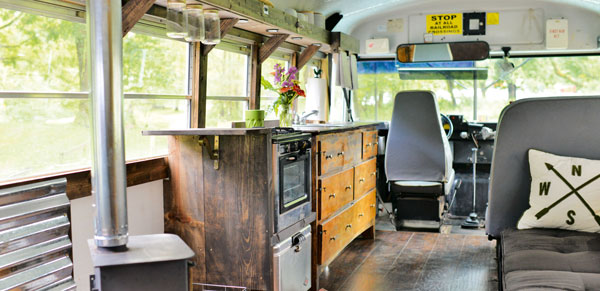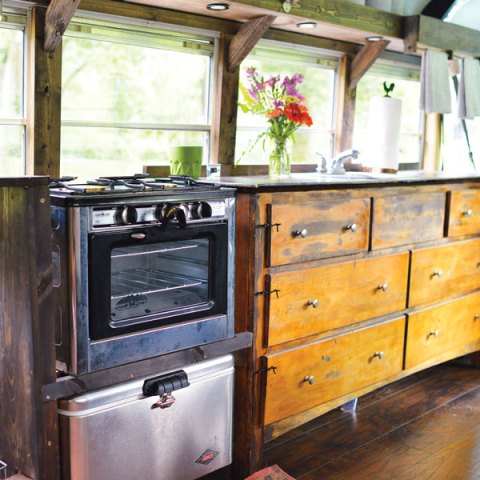Why a Converted School Bus Makes a Great Home
Converting a school bus into a skoolie offers a comfortable, affordable living space that can go anywhere the road might take you.
When you think of a school bus, you might not consider it as a potential dwelling. That’s understandable. We are familiar with pull-behind campers, motor homes, conversion vans, and tiny houses, so why consider a bus instead? There are four very good reasons.

Owning a skoolie is a wonderful lifestyle.
It gives you the freedom to roam. “Home is where you park it” is just one phrase that summarizes life in a skoolie. Unlike most dwellings, your skoolie will be unique and customized to your needs and preferences. When you embark on a road trip and reach your destination, your home will always stand out rather than blending in, making it feel even more special. Also, you will make skoolie friends! When you meet a fellow skoolie owner, there is a connection like no other. You will speak the same skoolie language, share the same experiences, and, most important, have a similar view of how to live alternatively.

A school bus is extremely durable.
A vehicle designed to transport 72 young lives is built with safety and sturdiness in mind. School buses are constructed on heavy-duty commercial truck frames by bus manufacturers such as Blue Bird and Thomas. The school bus body itself is framed with steel tubing and covered with steel paneling. On the exterior, there are additional thin sections of corrugated steel: known as rub rails, these are designed to minimize body damage from sideswiping and add to the structural integrity of the bus.
On top of a school bus, you will find a steel-framed, rounded metal roof designed to withstand extreme pressure from a rollover accident. Inside, light-gauge steel panels on the walls and ceiling are most commonly attached with rivets, but sometimes (especially in older buses) they are attached with regular screws. Under the hood, nearly all school buses feature diesel engines, which are known for their commercial-grade durability and power. Needless to say, a school bus is built tough!
By contrast, regular campers and RVs are constructed with affordability and weight in mind. A quick Internet search of “RV accidents” will give you an idea of what happens to them in a wreck. RVs are largely constructed with lightweight wood and fiberglass for the walls and roof. The roofs are flat, making them prone to water damage if they are not sealed and kept under cover regularly.
Tiny homes are solidly built and typically feature the same materials and construction as regular-size homes, but they are designed more for a permanent location rather than frequent travel. Tiny homes typically are mounted on trailers as a way to avoid building code restrictions and to make them technically movable (as in nonpermanent dwellings). They’re not really designed to be routinely out and about on the highway.

School buses are well maintained.
School systems maintain their buses as a fleet. The phrase “fleet maintained” seen in ad listings is a good thing! Each bus gets routine oil changes and thorough inspections, and repair and maintenance costs are prebudgeted, so issues are quickly taken care of. By contrast, if you’re shopping for an affordable used RV, it’s possible the previous owner neglected to repair an issue in a timely fashion, which could lead to more wear and tear on other parts as well as a compromised overall mechanical function — problems you will have to face as the new owner.

School buses are affordable.
Most school systems retire some buses each year based on age or mileage. I have found that most buses are kept in service for up to 10 years or 250,000 miles. Retired buses are usually auctioned off or sold in bulk to a dealer. A typical school bus may be auctioned for roughly a tenth of the cost of a used motor home or a tiny house.
Used RVs and tiny homes simply cannot compete with the value of a used school bus. Sure, there are many happy folks traveling in traditional motor homes and sleeping in trendy tiny homes, but maybe you don’t have that kind of budget, and maybe you want to go enjoy your life and independence sooner rather than later.
In addition, skoolies are simply cool! Skoolie owners soak up frequent thumbs-ups and peace signs from other drivers and enjoy giving the inquisitive couple at every stop a glimpse into their creative, unique, and liberating skoolie lifestyle.
Regardless of how large or small your budget is, how many windows your bus has, how elaborate your interior is, or how large your solar array may be, owning a skoolie promises an adventurous life in a comfortable home that’s also a reliable vehicle.











